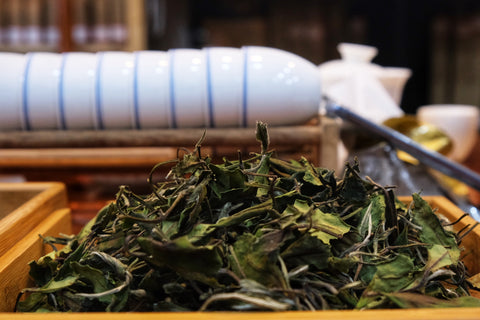The Browning of White Tea
While sourcing teas in China, we are constantly met with new discoveries about the tea making process and clearer understandings of what’s happening behind the scenes in the Chinese tea market. This is a story about one such discovery: Brown Shoumei.

Brown Shoumei (left) Green Shoumei (right) both produced in Autumn of 2020 by different producers.
While in Fuding in Autumn of 2020, we came across a lot of fresh white tea that looked aged. White tea should be green when it is first made, and yet, almost all the recently made tea was brown. We’ve seen browned white teas in other regions of China, in Hubei and Hunan, but their browning process involves Yaoqing, a shake wilting and slight oxidization. The resultant tea tastes more closely related to red tea than white, and yet, the teas here in Fuding didn’t have any of the traditional oxidized flavors. We asked about this with our main producer and he explained whats going on in Fuding: if there is too much wet heat in the leaves during production, the leaves will turn brown, it is much more difficult to get a green shoumei.

Proper production methods for White Tea. Notice the very thin layer of leaves on elevated wire mesh screens, this gives equal sun exposure while allowing wind to air dry the leaves as well.
So the brown shoumei was a result of improper production, then why is it so popular? We sampled some brown shoumei, it tasted fine, though didn’t have any of the fresh grassiness and floral notes that a fresh shoumei should have. The producers making the brown shoumei told us that it is not only easier to produce, but it sells better.
Inferior tea sells better? Why? Well, the people buying this brown shoumei are not marketing it as improperly made white tea, they’re pressing it into cakes and selling it as aged white tea. To us, this conspiracy goes deep. It starts with the farmer, continued by the wholesaler, and if the retailer is not double checking sources and facts, the lie then gets passed onto the consumer. Everyone in this chain is responsible for propagating this lie. Why? Because it is the duty of conscious consumers and of ethical vendors to do the research behind the teas they are buying and selling. An aged white tea that sells for a few dollars a cake it just not possible.

Incredibly cheap brown shoumei available in bulk at the 2020 Fuding wholesale tea market.
The farmers are not to blame here. The farmers are simply making tea that suits the market, their goal is to sell tea, their livelihood involves selling tea. If the market wants brown shoumei, they will make brown shoumei.
In recent years however, things have gotten out of hand. It is becoming increasingly difficult to find high-quality green shoumei, because it just doesn’t sell at its worth. Remember, it takes more work to produce green shoumei, and yet the market’s perception is growing toward believing that shoumei should be brown. Thus, a green shoumei is not only less desirable, it no longer fits the mold the market has made for what a shoumei should be.
At this critical point in time, the quality of aged white tea is in crisis. When a shoumei is browned, it loses many of its floral and vegetal notes. These are the very flavor points that transform to give aged tea its honey and dried flower flavors. A browned shoumei will simply not developed these more complex aromas, but rather become increasingly woodsy with much more peat and earth aromas in the final

2015 shoumei, produced green and naturally aging. Many people assume a 2015 shoumei should be entirely brown, but this is not the case with green-produced shoumei.
What can we do? We can do our part to educate the market, to do the research and support the farmers that are continuing to make green shoumei in their traditional ways. As vendors, we can press these green shoumei teas in to new cakes and age them for the long haul to ensure their unadulteration. As consumers, we can work with producers we trust, we can follow the leaf all the way back to the bush and go beyond the cake.

Green Shoumei harvested in September 2020
Tea is about understanding, about learning and comparing. In hopes of deepening understanding, we offer the brown shoumei produced by a less-successful family farm on the fringes of Fuding, and even have a comparison box comparing this brown shoumei with the properly produced green

Derek checking out the proper production methods used by the producer of the 2020 Green Shoumei.